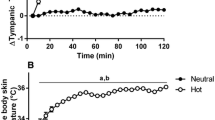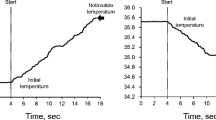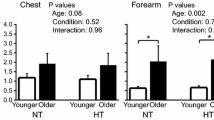Abstract
To investigate thermal responses of children during cold exposure, children and their mothers were exposed to identical environmental conditions in climatic chambers. Subjects comprised 14 mothers (age, 29–40 years) and 15 children (age, 15 months–3 years; 9 boys, 6 girls). Each mother and child wore a t-shirt and short pants over underwear. Subjects were initially seated in a chamber at 25°C for 60 min, then moved to a chamber at 15°C where they were seated for 30 min. During the recovery period, they were returned to the 25°C chamber and kept there for an additional 30 min. During exposure to 15°C, declines in skin temperature (T s) of the hand and foot were significantly greater in children than in mothers. Rectal temperatures (T re) of children increased during cold exposure, whereas T re of mothers decreased. This variation in T re in children might be linked to homodynamic alterations accompanied by greater decreases in T s of the extremities due to a greater degree of vasoconstriction in distal regions during cold exposure. Increases in T re during cold exposure for children correlated with body surface area to mass (Ab/mass), mass and decreases in T s of the abdomen, thigh and leg. During the rewarming period, children exhibited a greater increase in T s of the arm, hand and foot than mothers, and this was attributed to greater relaxation of vasoconstriction in distal regions of children during exposure to the thermoneutral environment. T re in children and mothers decreased during the rewarming period. A gender difference was found only with regard to T re and heart rate (HR) responses in children during cold exposure, and neither physical characteristics nor any T s differed between genders. Furthermore, no significant differences were observed in resting HR of mothers and girls, whereas boys showed significantly lower heart rates at 15°C than at 25°C.


Similar content being viewed by others
References
Aherne W, Hull D (1966) Brown adipose tissue and heat production in the newborn infant. J Pathol Bacteriol 91:223–234
Bittel JH, Nonotte-Varly C, Livecchi-Gonnot GH, Savourey GL, Hanniquet AM (1988) Physical fitness and thermoregulatory reactions in a cold environment in men. J Appl Physiol 65(5):1984–1989
Bollinger A, Schlumpf M (1976) Finger blood flow in healthy patients of different age and sex and in patients with primary Raynauds disease. Acta Chir Scand 465:42–47
Bruck K (1961) Temperature regulation in the newborn infant, Bil. Neonatorum 3:65–119
Budd GM, Warhaft N (1966) Body temperature, shivering, blood pressure and heart rate during a standard cold stress in Australia and Antarctica. J Physiol 186(1):216–232
Budd GM, Brotherhood JR, Hendrie AL, Jeffery SE (1991) Effects of fitness, fatness, and age on men’s responses to whole body cooling in air. J Appl Physiol 71(6):2387–2393
Burse RL (1979) Sex differences in human thermoregulatory response to heat and cold stress. Hum Factors 21:687–699
Buskirk ER, Thompson RH, Whedon GD (1963) Metabolic responses to cold air in men and women in relation to total body fat content. J Appl Physiol 18:603–612
Davies PSW (1996) Total energy expenditure in young children. Am J Hum Biol 8:183–188
Falk B (1998) Effects of thermal stress during rest and exercise in the paediatric population. Sports Med 25(4):221–240
Fujimoto K, Watanabe T, Sakamoto A, Yukawa K, Morimoto K (1967) Studies on the physiological area of Japanese 18. Calculation formula in three stages over all age (in Japanese). Jpn J Hyg 21:443–450
Graham TE, Lougheed MD (1985) Thermal responses to exercise in the cold: influence of sex differences and alcohol. Hum Biol 57(4):687–698
Hardy JD, DuBois E (1937) The technic of measuring radiation and convection. Nutrition 15(5):461–475
Heaton JM (1972) The distribution of brown adipose tissue in the human. J Anat 112(1):35–39
Hull D, Smales ORC (1978) Heat production in the newborn. In: Sinclair JC (ed) Temperature regulation and energy metabolism in the newborn. Grune & Stratton, New York, pp 129–156
Inoue Y, Araki T, Tsujita J (1996) Thermoregulatory responses of prepubertal boys and young men in changing temperature linearly from 28 to 15°C. Eur J Appl Physiol 72:204–208
Inoue Y, Nakamura S, Yonehiro K, Kuwahara T, Ueda H, Araki T (2006) Regional differences in peripheral vasoconstriction of prepubertal boys. Eur J Appl Physiol 96(4):397–403
Itoh S, Kuroshima A (1967) Distribution of brown adipose tissue in Japanese newborn infants. J Physiol Soc Jpn 29:660–661
Klentrou P, Cunliffe M, Slack J, Wilk B, Bar-Or O, De Souza MJ, Plyley M (2003) Temperature regulation during rest and exercise in the cold in premenarcheal and menarcheal girls. J Appl Physiol 96(4):1393–1398
Kollias J, Barlett L, Bergsteinova V, Skinner JS, Buskirk ER, Nicholas WC (1974) Metabolic and thermal responses of women during cooling in water. J Appl Physiol 36:577–580
McArdle WD, Magel JR, Gergley TJ, Spina RJ, Toner MM (1984) Thermal adjustment to cold-water exposure in resting men and women. J Appl Physiol 56(6):1565–1571
Merklin RJ (1974) Growth and distribution of human fetal brown fat. Anat Rec 178:637–646
Osada Y, Yoshida K, Ogawa S, Hirokawa A, Kikuchi K, Ohkubo C (1972) On the difference between men and women in their response to cold. Bull Inst Public Health (Tokyo) 21(2):60–67
Raven PB, Niki I, Dahms TE, Horvath SM (1970) Compensatory cardiovascular responses during an environmental cold stress, 5°C. J Appl Physiol 29:417–421
Raven PB, Wilkerson JE, Horvath SM, Bolduan NW (1975) Thermal, metabolic, and cardiovascular responses to various degrees of cold stress. Can J Physiol Pharmacol 53:293–298
Sloan REG, Keatinge WR (1973) Cooling rates of young people swimming in cold water. J Appl Physiol 35(3):371–375
Smolander J, Bar-or O, Korhonen O, Ilmarinen J (1992) Thermoregulation during rest and exercise in the cold in pre-and early pubescent boys and in young men. J Appl Physiol 72(4):1589–1594
Stevens GH, Graham TE, Wilson BA (1987) Gender differences in cardiovascular and metabolic responses to cold and exercise. Can J Physiol Pharmacol 65(2):165–171
Tsuzuki K, Iizuka S, Mitsutsuji S, Ikeda A, Tomita J, Tohihara Y, Ohnaka T (2001) Typical thermal environment for young children dwelling in and around the Tokyo metropolitan area. J Home Econ 52(5):429–438
Wagner JA, Robinson S, Marino RP (1974) Age and temperature regulation of humans in neutral and cold environments. J Appl Physiol 37(4):562–565
Wagner JA, Horvath SM (1985) Influences of age and gender on human thermoregulatory responses to cold exposures. J Appl Physiol 58(1):180–186
White MD, Ross WD, Mekjavic IB (1992) Relationship between physique and rectal temperature cooling rate. Undersea Biomed Res 19(2):121–130
Author information
Authors and Affiliations
Corresponding author
Rights and permissions
About this article
Cite this article
Tsuzuki, K., Tochihara, Y. & Ohnaka, T. Comparison of thermal responses between young children (1- to 3-year-old) and mothers during cold exposure. Eur J Appl Physiol 103, 697–705 (2008). https://doi.org/10.1007/s00421-008-0730-x
Accepted:
Published:
Issue Date:
DOI: https://doi.org/10.1007/s00421-008-0730-x




